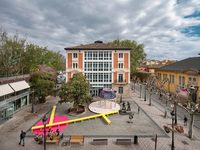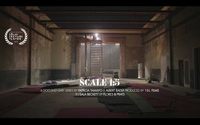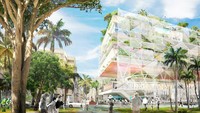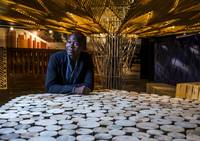Vallecas 2048
Madrid
Scenarios for the regeneration of a suburb in Madrid
"This project is part of the collective research "Bubblescapes - project for the reuse of the landscapes produced by the Spanish housing bubble". Our thesis is meant to improve the structural conditions of a suburban district in Madrid: Vallecas, which offers an exemplary case study of the European urban and economic dynamics of the last thirty years."
After a research trip through Spanish speculative landscapes, with the supervision of D.T. Ferrando (PoliTo) and I. Vagge (UniMi), we discovered Ensanche de Vallecas. Edified in the early 2000, following speculative logical, the urban scenario that has been created is characterized by huge spaces drowned in an absolute monotony, where the role of public space is annihilated by the redundancies of quantitatively well-organized areas, which, though, lack of any quality, conceived just in order to increase the value of the properties for sale. The exasperation of the post-speculative critical issues in Vallecas -common in Madrid’s PAUs- justifies the choice of Ensanche de Vallecas as a case study.
The selected working method consists in proceeding through "scenarios". Two scenarios have been developed: the first one requires an exiguous expense, but it is immediately viable; the other one may be finished by 2048, with a higher investment. 2048 represents a crucial year, it will occur exactly 50 years after "ley del todo urbanizable" -which opened to the possibility of converting agricultural land into building spaces- and 40 years after the burst of the Spanish real estate bubble. The first scenario involves the conversion of empty lots in agricultural spaces, while waiting to be edified. Thanks to the temporary reuse of these areas, the sense of incompleteness that pervades Vallecas will be attenuated, reintroducing the farming practice, identity sign of the district until 2000.
The second scenario aims to the realization of a new "compact city". In order to reach this goal, it has been necessary to rebalance public and private spaces. This whole operation -missing national regulations- was made following the Italian urban rules and standards. The city will be capable to host twice as many people as it was evaluated in the original plan, around two thirds of how many should reside in Valdecarros (new zone of planned expansion in Vallecas district -not yet realized-).
New Vallecas will be built with different logics from the ones that moved the first project, it will become a place on a human scale, where public spaces will be uniformly spread on the territory. These areas will be valuated and re-qualified, bringing them back to the role they were meant to fulfil as places of aggregation. Moving Valdecarros inhabitants to the new Vallecas will limit the consume of land from 1900 hectares to 200, returning 1700 hectares to agriculture. It is reasonable to believe that this new farmed band could be connected to the adjoining Parque Regional de Sureste, becoming "suelo protejido", blocking the uncontrolled expansion of the town.
The thesis is concluded with the examination of five "urban situation" in which, through the strategy of "recycle", some typical problems of Madrid’s PAUs can be solved.
- Ubicación
- Madrid
Proyectos relacionados
Magazine
-
-
-
-
Un despatx madrileny signa un visionari catalitzador urbà en West Palm Beach
Andrea Pala | 29.11.2018 -
L'arquitectura de Francis Keré en escena en el Museu ICO de Madrid
Andrea Pala | 28.10.2018









